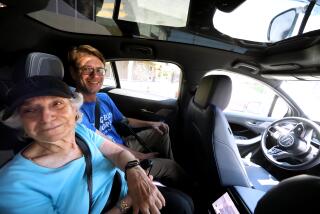Build a Robot, Donât Be One
AUSTIN, Texas â The empty mall store that was home to the seventh annual Robofest, held here earlier this month, looked like a cross between a high school science fair and a scene from a âMad Maxâ movie.
An entire wall was covered with a demented collage of animated junk. A robotic âcentipede,â which looked like a junkyard alligator, sat on the floor. A very strange, red nylon humanoid, a âmartial arts robot,â powered by servos and compressed air, flailed away energetically, at one point kicking the batteries out of a guyâs video camera.
The air was filled with a happy cacophony of horns, sirens, motors, computer beeps and the laughter and shrieks of kids. It was all a lot of fun.
Robofest might best be described as an anti-trade show: Everything is funky, everything is homemade, and youâre supposed to get down on the floor and play with it. Itâs the brainchild of an odd collection of Texans who call themselves the Robot Group (https://www.robotgroup.org/), a volunteer organization that promotes what they call âgrass-roots technoculture.â
The Robot Group includes artists, who work with both high-tech equipment and salvage yard scrap, serious robotics experts and hobbyists, and social activists who believe that democracy and social equality must be tied to technological mastery and demystification. One of Robot Groupâs founders, David Santos, said his involvement started with a precursor group called Silicon Barrio, which tried to bring computers to poor kids in east Austin 10 years ago.
âWe found that the kids liked playing with things and ideas,â says Santos. âSo when the space shuttle was recovering a satellite with a robot arm, and the kids could watch that on TV, we decided to build a robot arm that they could use too.â
They did more than that. The volunteers built a life-size mock-up of the space shuttle on an elementary school playground in east Austin, complete with a robot arm that recovered âsatellitesâ made out of helium-filled silver Mylar balloons.
Some kids operated the robot arm while others, inside the school, monitored the whole experience via remote-control âterminalsâ and video links, just like NASAâs ground control operation.
The Robot Group went on to build an attention-grabbing, 14-foot-long blimp--again made out of silver Mylar--controlled by a computer chip with a neural network program that made the blimp âcuriousâ about its surroundings. It was a little eerie to see a blimp in a hotel lobby slowly nosing its way around the open space without hitting walls or the ceiling. The blimp appeared to be looking for something--and with its weird flapping wings, small enough to look like vestiges of bird wings, it seemed fascinatingly âalive.â
*
The Robot Groupâs machines are a brilliant combination of technical wizardry, artistry and the skills of scavengers. Mark Pauline, the Cecil B. De Mille of robot performance art, via his Survival Research Labs (https://www.srl.org/) in San Francisco, said at Robofest, âItâs more fun to build things out of junk you find or that other people think they have no more use for.â
The Robot Group, Pauline and their colleagues around the world are clearly state of the art in engineering expertise, but what they do with that expertise is something corporations would never dream of.
Pauline, for example, showed a videotape of SRLâs recent âperformanceâ in Phoenix, a 45-minute show of over 30 tons of monster-size, remote-controlled robots smashing into each other, setting each other on fire, demolishing buildings and scaffolding, all accompanied by screaming industrial horns, sirens and 40-foot blasts of flame.
The camera panned over the thousands of people watching from behind barricades--every face was slack-jawed at the near-chaotic spectacle of robot mayhem.
*
Why do this? Why build robots that donât do anything but smash each other or kick like a Thai kick boxer or fly slowly into nooks and crannies?
One obvious answer: for fun. Everyone at Robofest, especially first-time attendees, wandered around with an expression full of both wonder and delight--you can see what theyâre thinking: âThis is the craziest thing Iâve ever seen in my life!â
But thereâs a subtle, almost subliminal, political message underlying Robofest and Paulineâs performance art. As the world becomes more and more roboticized, we run the risk of becoming stupid and lazy human bystanders, stripped of skills and competence.
Very few people can fix a car anymore, or a toaster or a radio. Yet many of the technical geniuses we celebrate today report that their first experiences with technology were taking apart the family radio or fooling around with cars, home appliances or early computers.
Now weâre surrounded by technology so mysterious and opaque it seems to have been delivered by aliens. And if we canât fix the things that surround us in our daily lives, how can we hope to fix our political system or our society, which seem even more complex and intractable?
But playing with machines helps us remember that we can control technology for our own purposes, even to have pointless fun or to make symbolic statements about our high-tech society. Pauline says, âTechnology is supposed to make life more interesting, and I honestly believe that it can, although other things usually get in the way, like making money or projecting political power.â
The message of the wacky and wonderful Robofest? Having fun with robots--âgrass-roots technocultureâ--may help prevent us from turning each other into robots.
Gary Chapman is director of the 21st Century Project at the University of Texas in Austin. He can be reached at [email protected]
More to Read
Sign up for Essential California
The most important California stories and recommendations in your inbox every morning.
You may occasionally receive promotional content from the Los Angeles Times.










